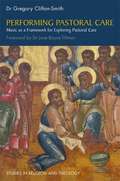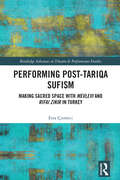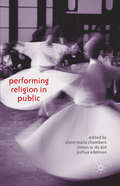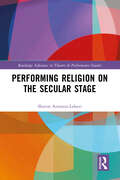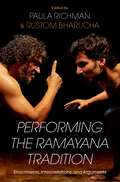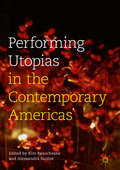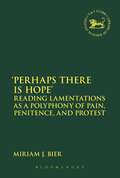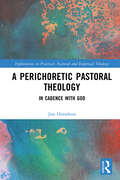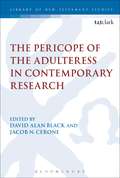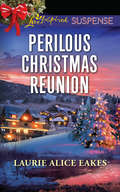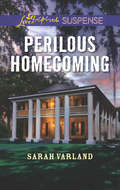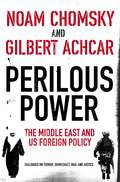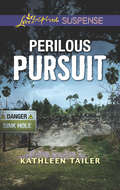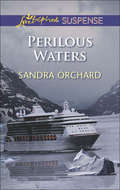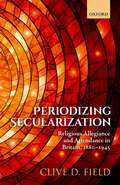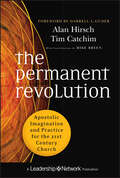- Table View
- List View
Performing Pastoral Care: Music as a Framework for Exploring Pastoral Care
by June Boyce-Tillman Gregory Clifton-SmithMaking the case for the relevance of pastoral care today, this book explores the role of pastoral care through the prism of music. Using musical analogies, the author provides a new way of understanding and practising pastoral care, grounded in practical theology. Challenging overemphasis on mission, he shows that pastoral care remains essential to the life of the church, especially when engaging with extreme situations such as dying, suffering or war, and considers the role of pastoral carers in the specific pastoral encounter and in the life of the church in general.
Performing Pastoral Care: Music as a Framework for Exploring Pastoral Care (PDF)
by Gregory Clifton-Smith June Boyce-TillmanMaking the case for the relevance of pastoral care today, this book explores the role of pastoral care through the prism of music. Using musical analogies, the author provides a new way of understanding and practising pastoral care, grounded in practical theology. Challenging overemphasis on mission, he shows that pastoral care remains essential to the life of the church, especially when engaging with extreme situations such as dying, suffering or war, and considers the role of pastoral carers in the specific pastoral encounter and in the life of the church in general.
Performing Post-Tariqa Sufism: Making Sacred Space with Mevlevi and Rifai Zikir in Turkey (Routledge Advances in Theatre & Performance Studies)
by Esra ÇizmeciThis ethnographic research project examines the generation of post-tariqa Tasavvuf (Sufism: a spiritual practice and philosophy recognised as the inner dimension of Islam) in a variety of private, semi-public, public, secular and sacred urban spaces in present-day Turkey. Through extensive field research in minority Sufi communities, this book investigates how devotees of specific orders maintain, adapt, mobilise, and empower their beliefs and values through embodied acts of their Sufi followers. Using an ethnographic methodology and theories derived from performance studies, Esra Çizmeci examines the multiple ways in which the post-tariqa Mevlevi and Rifai practice is formed in present-day Turkey, such as through the authority of the spiritual teacher; the individual and collective performance of Sufi rituals; nefs (self) training; and, most importantly, the practice of Sufi doctrines in everyday life through the production of sacred spaces. Drawing on the theories of performance, she examines how the Sufi way of living and spaces are created anew in the process of each devotee’s embodied action. This book is informed by theories in performance studies, anthropology, religious studies, and cultural studies and places current Sufi practices in a historical perspective.
Performing Post-Tariqa Sufism: Making Sacred Space with Mevlevi and Rifai Zikir in Turkey (Routledge Advances in Theatre & Performance Studies)
by Esra ÇizmeciThis ethnographic research project examines the generation of post-tariqa Tasavvuf (Sufism: a spiritual practice and philosophy recognised as the inner dimension of Islam) in a variety of private, semi-public, public, secular and sacred urban spaces in present-day Turkey. Through extensive field research in minority Sufi communities, this book investigates how devotees of specific orders maintain, adapt, mobilise, and empower their beliefs and values through embodied acts of their Sufi followers. Using an ethnographic methodology and theories derived from performance studies, Esra Çizmeci examines the multiple ways in which the post-tariqa Mevlevi and Rifai practice is formed in present-day Turkey, such as through the authority of the spiritual teacher; the individual and collective performance of Sufi rituals; nefs (self) training; and, most importantly, the practice of Sufi doctrines in everyday life through the production of sacred spaces. Drawing on the theories of performance, she examines how the Sufi way of living and spaces are created anew in the process of each devotee’s embodied action. This book is informed by theories in performance studies, anthropology, religious studies, and cultural studies and places current Sufi practices in a historical perspective.
Performing Punk (Cultural Sociology)
by Erik HannerzPerforming Punk is a rich exploration of subcultural contrasts and similarities among punks. By investigating how punk is made, for whom, and in opposition to what, this book takes the reader on a journey through the lesser-known aspects of the punk subculture.
Performing Religion in Public
by Claire Maria Chambers, Simon W. du Toit and Joshua EdelmanReligious life and public life are both passionately performed, but often understood to exclude one another. This book's array of voices investigates the publics hailed by religious performances and the challenges they offer to theories of the democratic public sphere.
Performing Religion on the Secular Stage (Routledge Advances in Theatre & Performance Studies)
by Sharon Aronson-LehaviThis book examines the relations between Western religion, secularism, and modern theater and performance. Sharon Aronson-Lehavi posits that the ongoing cultural power of religious texts, icons, and ideas on the one hand and the artistic freedom enabled by secularism and avant-garde experimentalism on the other, has led theatre artists throughout the twentieth century to create a uniquely modern theatrical hybrid–theater performances that simultaneously re-inscribe and grapple with religion and religious performativity. The book compares this phenomenon with medieval forms of religious theater and offers deep and original analyses of significant contemporary works ranging from plays and performances by August Strindberg, Hugo Ball (Dada), Jerzy Grotowski, and Hanoch Levin, to those created by Adrienne Kennedy, Rina Yerushalmi, Deb Margolin, Milo Rau, and Sarah Ruhl. The book analyzes a new and original historiography of a uniquely modern theatrical phenomenon, a study that is of high importance considering the reemergence of religion in contemporary culture and politics.
Performing Religion on the Secular Stage (Routledge Advances in Theatre & Performance Studies)
by Sharon Aronson-LehaviThis book examines the relations between Western religion, secularism, and modern theater and performance. Sharon Aronson-Lehavi posits that the ongoing cultural power of religious texts, icons, and ideas on the one hand and the artistic freedom enabled by secularism and avant-garde experimentalism on the other, has led theatre artists throughout the twentieth century to create a uniquely modern theatrical hybrid–theater performances that simultaneously re-inscribe and grapple with religion and religious performativity. The book compares this phenomenon with medieval forms of religious theater and offers deep and original analyses of significant contemporary works ranging from plays and performances by August Strindberg, Hugo Ball (Dada), Jerzy Grotowski, and Hanoch Levin, to those created by Adrienne Kennedy, Rina Yerushalmi, Deb Margolin, Milo Rau, and Sarah Ruhl. The book analyzes a new and original historiography of a uniquely modern theatrical phenomenon, a study that is of high importance considering the reemergence of religion in contemporary culture and politics.
Performing the Ramayana Tradition: Enactments, Interpretations, and Arguments
by Paula Richman and Rustom BharuchaThe Ramayana, one of the two pre-eminent Hindu epics, has played a foundational role in many aspects of India's arts and social norms. For centuries, people learned this narrative by watching, listening, and participating in enactments of it. Although the Ramayana's first extant telling in Sanskrit dates back to ancient times, the story has continued to be retold and rethought through the centuries in many of India's regional languages, such as Hindi, Tamil, and Bengali. The narrative has provided the basis for enactments of its episodes in recitation, musical renditions, dance, and avant-garde performances. This volume introduces non-specialists to the Ramayana's major themes and complexities, as well as to the highly nuanced terms in Indian languages used to represent theater and performance. Two introductions orient readers to the history of Ramayana texts by Tulsidas, Valmiki, Kamban, Sankaradeva, and others, as well as to the dramaturgy and aesthetics of their enactments. The contributed essays provide context-specific analyses of diverse Ramayana performance traditions and the narratives from which they draw. The essays are clustered around the shared themes of the politics of caste and gender; the representation of the anti-hero; contemporary re-interpretations of traditional narratives; and the presence of Ramayana discourse in daily life.
Performing the Ramayana Tradition: Enactments, Interpretations, and Arguments
The Ramayana, one of the two pre-eminent Hindu epics, has played a foundational role in many aspects of India's arts and social norms. For centuries, people learned this narrative by watching, listening, and participating in enactments of it. Although the Ramayana's first extant telling in Sanskrit dates back to ancient times, the story has continued to be retold and rethought through the centuries in many of India's regional languages, such as Hindi, Tamil, and Bengali. The narrative has provided the basis for enactments of its episodes in recitation, musical renditions, dance, and avant-garde performances. This volume introduces non-specialists to the Ramayana's major themes and complexities, as well as to the highly nuanced terms in Indian languages used to represent theater and performance. Two introductions orient readers to the history of Ramayana texts by Tulsidas, Valmiki, Kamban, Sankaradeva, and others, as well as to the dramaturgy and aesthetics of their enactments. The contributed essays provide context-specific analyses of diverse Ramayana performance traditions and the narratives from which they draw. The essays are clustered around the shared themes of the politics of caste and gender; the representation of the anti-hero; contemporary re-interpretations of traditional narratives; and the presence of Ramayana discourse in daily life.
Performing Utopias in the Contemporary Americas
by Kim Beauchesne Alessandra SantosThis book offers an innovative examination of the utopian impulse through performance as a proposition of practical engagement in the contemporary Americas. The volume compiles unique multidisciplinary and exploratory texts, applying diverse critical and artistic approaches. Its contributors reconceptualize utopia as a creative and theoretical method based on a commitment to sociopolitical transformation. Chapters are organized around notions of mapping utopias, indigenizing practices, political manifestations, and the construction of social identities.
'Perhaps there is Hope': Reading Lamentations as a Polyphony of Pain, Penitence, and Protest (The Library of Hebrew Bible/Old Testament Studies #603)
by Miriam J. BierBier proposes here a strong new understanding of the Book of Lamentations, drawing on Bakhtinian ideas of multiple voices to analyse the poetic speaking voices within the text; examining their theological perspectives, and nuancing the interaction between them. Bier scrutinises interpretations of Lamentations, distinguishing between exegesis that reads Lamentations as a theodicy, in defense of God, and those that read it as an anti-theodicy, in defense of Zion. Rather than reductively adopting either of these approaches, this book advocates a dialogic approach to Lamentations, reading to hear the full polyphony of pain, penitence, and protest.
A Perichoretic Pastoral Theology: In Cadence with God (Explorations in Practical, Pastoral and Empirical Theology)
by Jim HorsthuisThis book articulates a perichoretic pastoral theology, offering a pastoral theological response to the question of how ministering persons practice ministry in communion with the triune God. Key elements from contemporary pastoral theology—theologies of human experience, concern for human suffering, and situational attentiveness—are drawn into conversation with the doctrine of perichoresis. Jim Horsthuis provides a vision for life and ministry in relational, participational and spiritual communion with the Father, Son and Holy Spirit. The chapters explore four spiritual movements that foster this vision: (1) the move from experience to relationship; (2) the move from concern to presence; (3) the move from competence to communion; and (4) the move from practice to prayer. The book represents a unique academic contribution to both pastoral theology and Trinitarian theology.
A Perichoretic Pastoral Theology: In Cadence with God (Explorations in Practical, Pastoral and Empirical Theology)
by Jim HorsthuisThis book articulates a perichoretic pastoral theology, offering a pastoral theological response to the question of how ministering persons practice ministry in communion with the triune God. Key elements from contemporary pastoral theology—theologies of human experience, concern for human suffering, and situational attentiveness—are drawn into conversation with the doctrine of perichoresis. Jim Horsthuis provides a vision for life and ministry in relational, participational and spiritual communion with the Father, Son and Holy Spirit. The chapters explore four spiritual movements that foster this vision: (1) the move from experience to relationship; (2) the move from concern to presence; (3) the move from competence to communion; and (4) the move from practice to prayer. The book represents a unique academic contribution to both pastoral theology and Trinitarian theology.
The Pericope of the Adulteress in Contemporary Research (The Library of New Testament Studies #551)
by David Alan Black Jacob N. CeroneThe contributors to this volume (J.D. Punch, Jennifer Knust, Tommy Wasserman, Chris Keith, Maurice Robinson, and Larry Hurtado) re-examine the Pericope Adulterae (John 7.53-8.11) asking afresh the question of the paragraph's authenticity. Each contributor not only presents the reader with arguments for or against the pericope's authenticity but also with viable theories on how and why the earliest extant manuscripts omit the passage. Readers are encouraged to evaluate manuscript witnesses, scribal tendencies, patristic witnesses, and internal evidence to assess the plausibility of each contributor's proposal. Readers are presented with cutting-edge research on the pericope from both scholarly camps: those who argue for its originality, and those who regard it as a later scribal interpolation. In so doing, the volume brings readers face-to-face with the most recent evidence and arguments (several of which are made here for the first time, with new evidence is brought to the table), allowing readers to engage in the controversy and weigh the evidence for themselves.
The Pericope of the Adulteress in Contemporary Research (The Library of New Testament Studies)
by David Alan Black Jacob N. CeroneThe contributors to this volume (J.D. Punch, Jennifer Knust, Tommy Wasserman, Chris Keith, Maurice Robinson, and Larry Hurtado) re-examine the Pericope Adulterae (John 7.53-8.11) asking afresh the question of the paragraph's authenticity. Each contributor not only presents the reader with arguments for or against the pericope's authenticity but also with viable theories on how and why the earliest extant manuscripts omit the passage. Readers are encouraged to evaluate manuscript witnesses, scribal tendencies, patristic witnesses, and internal evidence to assess the plausibility of each contributor's proposal. Readers are presented with cutting-edge research on the pericope from both scholarly camps: those who argue for its originality, and those who regard it as a later scribal interpolation. In so doing, the volume brings readers face-to-face with the most recent evidence and arguments (several of which are made here for the first time, with new evidence is brought to the table), allowing readers to engage in the controversy and weigh the evidence for themselves.
Perilous Christmas Reunion: Holiday Amnesia Bodyguard For Christmas Perilous Christmas Reunion (Mills And Boon Love Inspired Suspense Ser.)
by Laurie Alice EakesFamily secrets made her a target… Can her ex provide a holiday haven?
Perilous Homecoming: The Only Witness; Desert Secrets; Perilous Homecoming (Mills And Boon Love Inspired Suspense Ser.)
by Sarah VarlandFATAL BOUNTY When former Treasure Point police officer Kelsey Jackson witnesses a murder while temporarily back in her hometown, the killer is dead set on silencing her.
Perilous Power: Dialogues on Terror, Democracy, War, and Justice
by Noam Chomsky Gilbert Achcar Stephen R. ShalomThe volatile Middle East is a region of vast resources, frequent crises and long-standing conflicts, as well as a major source of international tensions and a key site of direct US intervention.Noam Chomsky, the preeminent critic on US foreign policy, and Gilbert Achcar, a leading Middle East specialist, bring a keen understanding of the Middle East and the role of the US, covering such key topics as terrorism, fundamentalism, oil and democracy, as well as the war in Afghanistan, the invasion and occupation of Iraq, the Israeli-Palestinian conflict and the origins of US foreign policy.
Perilous Pursuit (Mills And Boon Love Inspired Suspense Ser.)
by Kathleen TailerEvidence in their hands… And a crime ring on their trail.
Perilous Refuge: Hazardous Homecoming Silent Night Standoff Perilous Refuge (Mills And Boon Love Inspired Suspense Ser.)
by Kathleen TailerNowhere to turn
Perilous Waters: Top Secret Identity Wrongly Accused Perilous Waters Lancaster County Target (Mills And Boon Love Inspired Suspense Ser.)
by Sandra OrchardUNDER SUSPICION
Periodizing Secularization: Religious Allegiance and Attendance in Britain, 1880-1945
by Clive D. FieldMoving beyond the (now somewhat tired) debates about secularization as paradigm, theory, or master narrative, Periodizing Secularization focuses upon the empirical evidence for secularization, viewed in its descriptive sense as the waning social influence of religion, in Britain. Particular emphasis is attached to the two key performance indicators of religious allegiance and churchgoing, each subsuming several sub-indicators, between 1880 and 1945, including the first substantive account of secularization during the fin de siècle. A wide range of primary sources is deployed, many of them relatively or entirely unknown, and with due regard to their methodological and interpretative challenges. On the back of them, a cross-cutting statistical measure of 'active church adherence' is devised, which clearly shows how secularization has been a reality and a gradual, not revolutionary, process. The most likely causes of secularization were an incremental demise of a Sabbatarian culture (coupled with the associated emergence of new leisure opportunities and transport links) and of religious socialization (in the church, at home, and in the school). The analysis is also extended backwards, to include a summary of developments during the eighteenth and early nineteenth centuries; and laterally, to incorporate a preliminary evaluation of a six-dimensional model of 'diffusive religion', demonstrating that these alternative performance indicators have hitherto failed to prove that secularization has not occurred. The book is designed as a prequel to the author's previous volumes on the chronology of British secularization - Britain's Last Religious Revival? (2015) and Secularization in the Long 1960s (2017). Together, they offer a holistic picture of religious transformation in Britain during the key secularizing century of 1880-1980.
Periodizing Secularization: Religious Allegiance and Attendance in Britain, 1880-1945
by Clive D. FieldMoving beyond the (now somewhat tired) debates about secularization as paradigm, theory, or master narrative, Periodizing Secularization focuses upon the empirical evidence for secularization, viewed in its descriptive sense as the waning social influence of religion, in Britain. Particular emphasis is attached to the two key performance indicators of religious allegiance and churchgoing, each subsuming several sub-indicators, between 1880 and 1945, including the first substantive account of secularization during the fin de siècle. A wide range of primary sources is deployed, many of them relatively or entirely unknown, and with due regard to their methodological and interpretative challenges. On the back of them, a cross-cutting statistical measure of 'active church adherence' is devised, which clearly shows how secularization has been a reality and a gradual, not revolutionary, process. The most likely causes of secularization were an incremental demise of a Sabbatarian culture (coupled with the associated emergence of new leisure opportunities and transport links) and of religious socialization (in the church, at home, and in the school). The analysis is also extended backwards, to include a summary of developments during the eighteenth and early nineteenth centuries; and laterally, to incorporate a preliminary evaluation of a six-dimensional model of 'diffusive religion', demonstrating that these alternative performance indicators have hitherto failed to prove that secularization has not occurred. The book is designed as a prequel to the author's previous volumes on the chronology of British secularization - Britain's Last Religious Revival? (2015) and Secularization in the Long 1960s (2017). Together, they offer a holistic picture of religious transformation in Britain during the key secularizing century of 1880-1980.
The Permanent Revolution: Apostolic Imagination and Practice for the 21st Century Church (Jossey-Bass Leadership Network Series #57)
by Alan Hirsch Tim CatchimA new brand of apostolic ministry for today's world The Permanent Revolution is a work of theological re-imagination and re-construction that draws from biblical studies, theology, organizational theory, leadership studies, and key social sciences. The book elaborates on the apostolic role rooted in the five-fold ministry from Ephesians 4 (apostles, prophets, evangelists, shepherds, and teacher), and its significance for the missional movement. It explores how the apostolic ministry facilitates ongoing renewal in the life of the church and focuses on leadership in relation to missional innovation and entrepreneurship.The authors examine the nature of organization as reframed through the lens of apostolic ministry. Shows how to view the world through a biblical perspective and continue the "permanent revolution" that Jesus started Outlines the essential characteristics of apostolic movement and how to restructure the church and ministry to be more consistent with them Alan Hirsch is a leading voice in the missional movement of the Christian West This groundbreaking book integrates theology, sociology, and leadership to further define the apostolic movement.
